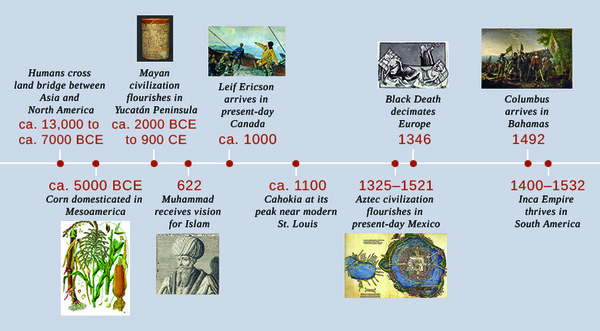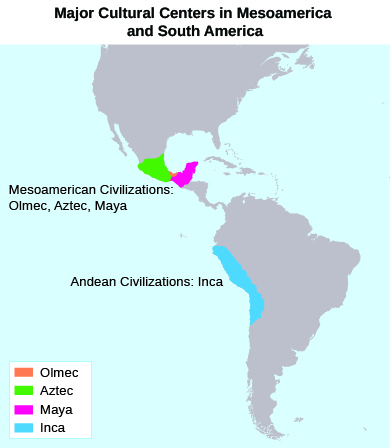| << Chapter < Page | Chapter >> Page > |

Between nine and fifteen thousand years ago, some scholars believe that a land bridge existed between Asia and North America that we now call Beringia . The first inhabitants of what would be named the Americas migrated across this bridge in search of food. When the glaciers melted, water engulfed Beringia, and the Bering Strait was formed. Later settlers came by boat across the narrow strait. (The fact that Asians and American Indians share genetic markers on a Y chromosome lends credibility to this migration theory.) Continually moving southward, the settlers eventually populated both North and South America, creating unique cultures that ranged from the highly complex and urban Aztec civilization in what is now Mexico City to the woodland tribes of eastern North America. Recent research along the west coast of South America suggests that migrant populations may have traveled down this coast by water as well as by land.
Researchers believe that about ten thousand years ago, humans also began the domestication of plants and animals, adding agriculture as a means of sustenance to hunting and gathering techniques. With this agricultural revolution, and the more abundant and reliable food supplies it brought, populations grew and people were able to develop a more settled way of life, building permanent settlements. Nowhere in the Americas was this more obvious than in Mesoamerica ( [link] ).

Mesoamerica is the geographic area stretching from north of Panama up to the desert of central Mexico. Although marked by great topographic, linguistic, and cultural diversity, this region cradled a number of civilizations with similar characteristics. Mesoamericans were polytheistic ; their gods possessed both male and female traits and demanded blood sacrifices of enemies taken in battle or ritual bloodletting. Corn, or maize, domesticated by 5000 BCE, formed the basis of their diet. They developed a mathematical system, built huge edifices, and devised a calendar that accurately predicted eclipses and solstices and that priest-astronomers used to direct the planting and harvesting of crops. Most important for our knowledge of these peoples, they created the only known written language in the Western Hemisphere; researchers have made much progress in interpreting the inscriptions on their temples and pyramids. Though the area had no overarching political structure, trade over long distances helped diffuse culture. Weapons made of obsidian, jewelry crafted from jade, feathers woven into clothing and ornaments, and cacao beans that were whipped into a chocolate drink formed the basis of commerce. The mother of Mesoamerican cultures was the Olmec civilization.

Notification Switch
Would you like to follow the 'U.s. history' conversation and receive update notifications?